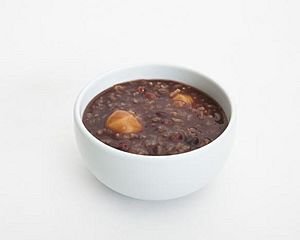Patjuk facts for kids

A bowl of patjuk (red bean porridge) with saealsim (rice cake balls)
|
|
| Alternative names |
red bean porridge
|
|---|---|
| Type | Juk |
| Place of origin | Korea |
| Region or state | East Asia |
| Associated national cuisine | |
| Main ingredients | Red beans, Rice |
| 58 kcal (243 kJ) | |
| Similar dishes | Hóngdòu tāng, shiruko |
Patjuk (pronounced "pat-jook") is a warm and comforting Korean porridge. It's made mainly from red beans and rice. This special dish is often enjoyed during the cold winter season in Korea. It's especially popular around dongji, which is the winter solstice. Many years ago, people believed that the bright red color of patjuk could help chase away bad spirits.
Contents
How to Make Patjuk
Making patjuk involves a few simple steps. First, red beans are boiled until they are super soft. This can take a while, usually with eight to ten parts water for every part of beans.
Preparing the Beans
Once the beans are cooked, they are mashed up. Then, they are pushed through a sieve to remove the tough bean skins. The smooth, mashed beans are left to sit. This allows them to separate into two layers. The clear water on top is used to cook the rice. The thicker red bean mash at the bottom is saved for later.
Adding Rice and Saealsim
When the rice is cooked and soft, the mashed beans are added back into the porridge. Small, chewy balls called saeal-sim (pronounced "say-al-shim") are also added. Saeal-sim means "bird's egg" in Korean. They are named this because they look like tiny bird's eggs. These little balls are made from sticky glutinous rice flour. Often, people add one saealsim for each year of their age! Finally, salt is added to make the porridge taste just right.
-
Saeal-sim (bird's eggs) made with rice flour and hot water
Different Kinds of Patjuk
Patjuk is usually eaten as a full meal, not as a sweet dessert. The basic version is not sweetened. It often includes saealsim, those fun rice cake balls.
- Sweet Red Bean Porridge (Dan-patjuk): This is a dessert version of patjuk. It's made from boiled and mashed red beans, but it's sweetened. Instead of rice grains, glutinous rice flour is mixed in. This sweet porridge is often made with honey or sugar. Saealsim are also a common addition to dan-patjuk.
- Red Bean Noodles (Pat-kal-guksu): This is a unique type of kal-guksu, which is a Korean noodle soup. In this dish, tasty noodles replace the usual rice and saealsim.
Patjuk in Korean Traditions
Patjuk is deeply connected to Korean culture and history. It's a big part of the winter season, especially on dongji, the winter solstice. This is the shortest day and longest night of the year.
Driving Away Bad Luck
Cooking and eating patjuk was once a special ritual. People believed it could prevent bad luck, diseases, and evil spirits. The red color of patjuk was very important. Red was seen as a powerful color of positive energy. It was thought to keep negative energy away.
There's a story about a man named Gong Gong. His son died on the winter solstice and became a spirit that spread sickness. This spirit was supposedly afraid of red bean porridge. So, people started making patjuk on the winter solstice to protect themselves. Before eating, Koreans would even offer patjuk to household gods, like the Kitchen God. Sometimes, they would smear patjuk on walls or doors, or place bowls of it in every room of their house.
A Dish for Farmers
The custom of eating patjuk in winter also comes from Korea's long history as a farming society. Having a good harvest was super important for people. Eating patjuk became a way to wish for lots of crops. By relaxing and eating nourishing food in winter, farmers could get ready for spring planting.
Winter was often a time when rice, a main food in Korean cuisine, was scarce. Patjuk, made mostly of red beans and water with less rice, was an affordable meal. It was also a complete meal on its own, meaning no extra side dishes were needed. Patjuk shows how people used to save food wisely.
Today, many of these old beliefs about spirits and farming traditions have changed. But patjuk is still a beloved seasonal dish enjoyed by many in Korea.
Gallery
-
Patjuk sold by a street vendor in Busan, South Korea
-
Pat-kal-guksu, a noodle soup
See also
 In Spanish: Patjuk para niños
In Spanish: Patjuk para niños





